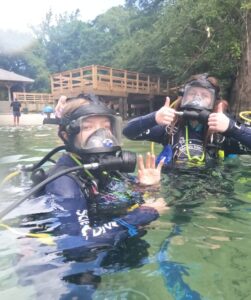At first the idea of diving with full face masks terrified me. I was comfortable diving with a normal regulator and mask, as I’d been doing so for 3 years. So many problems came into my head. What if water started leaking into the mask and I couldn’t get air? What if I got a fin to the face during diving and lost my source of air, as well as my sight? How would I equalize? Those were my concerns before I knew anything about diving with full face masks.
During the Panama City, FL. summer trip of 2024, my fellow nauts and I were introduced to the masks, and I realized that diving with full face masks is not at all scary and quite simple, really. Mr. Wendt, from Florida State University- Panama City, showed us how to fit and put on the masks, and explained the equalizing process.
It turns out, the masks have a nose piece inside that blocks your nose. When you go diving, all you have to do is blow out through your nose and equalize like normal, except the nose piece does the nose-holding for you! Along with that, full face masks have a separate inside seal that seals your nose and mouth. This makes it to where even if the mask fills with water, you can still breathe.
The full face masks also had built in snorkels. All you have to do is turn a knob type thing and then you can breathe on the surface without using your air, or having to take the mask off. Pretty neat, right?
Morrison Springs
My fellow nauts and I were taught some basic skills for diving with the full face masks. Some were simple, such as opening the snorkel underwater and letting the mask fill up, then clearing it. However, the main skill was a bit more complicated. We were instructed to remove the full face mask underwater, then switch to our alternate air source, put on our regular mask, (we had them clipped to our BC or in a pocket), then drop our regulator, take off our mask, and put the full face mask back on.

Nauts try out their new full face masks in deeper water while John sings Katy Perry over the communications system.
I personally have always had issues removing any mask underwater. I don’t like the shock of cold water hitting my face suddenly, it makes me feel like I can’t breathe. And it wasn’t helpful that our dive site was a 70°F spring. The idea of taking my mask off underwater made me nervous.
Our dive instructors had every naut do the skills, one by one. I completed the snorkel skill just fine and watched as my fellow nauts did the mask removal skill. Some were successful, others not. By the time it came to my turn I was practically frozen– I had been sitting there, barely moving for 30 minutes– so I waited for the next dive.
Success!!
When we got back in the water, I followed the steps. I breathed in water through my nose a few times, choked on it, but reminded myself to breathe through my mouth. I didn’t want to have to repeat the skill because I shot to the surface, so I slowly worked through it until I had my full face mask back on. It wasn’t nearly as bad as I expected.
And I did it!
Only 3 of the 11 nauts were able to complete all the skills, and I was one of them!
Afterwards, John and Elijah (the other two nauts who wanted to continue diving with full face masks) and I got to go on a fun dive and play around with the communications system. It’s so cool to be able to talk underwater! Unfortunately, I discovered it is hard to hear what is being said over the sound of your own breathing. But if you don’t want to listen to John singing Fireworks by Katy Perry, just do what Elijah did and breathe faster.
It’s such a different diving experience and I definitely want to dive with full face masks more in the future.
— Ainsley B., 1st Class Naut, Savannah Chapter


